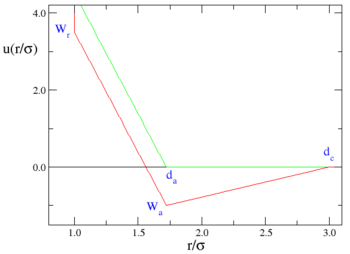Ramp model: Difference between revisions
Jump to navigation
Jump to search
m (→Critical points: potential parameters specified) |
|||
| Line 20: | Line 20: | ||
==Critical points== | ==Critical points== | ||
For the particular case <math> W_r^*=3.5; W_a^*=-1.0, d_a^*=1.72, d_c^*=3.0 </math>, | For the particular case <math> W_r^*=3.5; W_a^*=-1.0, d_a^*=1.72, d_c^*=3.0 </math>, | ||
the liquid-vapour critical point | the liquid-vapour critical point is located at (Ref. 4) | ||
:<math>T_c^* = 1.487 \pm 0.003</math> | :<math>T_c^* = 1.487 \pm 0.003</math> | ||
Revision as of 15:18, 26 February 2009
The ramp model, proposed by Jagla [1] and sometimes known as the Jagla model, is described by:
where is the intermolecular pair potential, , and .
Graphically, one has:

where the red line represents an attractive implementation of the model, and the green line a repulsive implementation.
Critical points
For the particular case , the liquid-vapour critical point is located at (Ref. 4)
and the liquid-liquid critical point is located at (Ref. 4)
See also
References
Related literature
- Limei Xu, Sergey V. Buldyrev, C. Austen Angell, and H. Eugene Stanley "Thermodynamics and dynamics of the two-scale spherically symmetric Jagla ramp model of anomalous liquids", Physical Review E 74 031108 (2006)
- E. Lomba, N. G. Almarza, C. Martin, C. McBride "Phase behaviour of attractive and repulsive ramp fluids: integral equation and computer simulation studies", Journal of Chemical Physics 126 244510 (2007)
- Limei Xu, Sergey V. Buldyrev, Nicolas Giovambattista, C. Austen Angell, and H. Eugene Stanley "A monatomic system with a liquid-liquid critical point and two distinct glassy states", Journal of Chemical Physics 130 054505 (2009)











